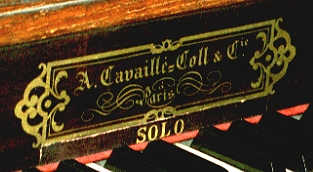

Aristide Cavaillé-Coll
|
| Chest Placement | Manual Order | Couplers | Review Quiz |
Chest PlacementAs a part of the organ's working mechanism, a Barker machine is not visible. Another innovation of the nineteenth century French organ does make a difference in the appearance of an organ:Cavaillé-Coll removed the Positif division from the gallery rail and placed it behind the Grand orgue in the main case.In Cavaillé-Coll's new organs the Positif no longer formed a separate visible component in the organ's visual design. When he was asked to rebuild an existing instrument, he often removed the Positif chest from its existing case and put it in the main case, leaving the old case empty of all but the façade pipes. His main goal, then, was not altering the appearance of the organ. If it had been, he could have just removed the old Positif case when he rebuilt an organ. He had a different goal - - changing how the Positif worked within an instrument. In its older position, its stops had less power but more presence than those of the Grand Orgue. The sound of the Positif was lighter by virtue of the higher pitch level of its Montre, the fundamental principal stop. The other stops of the Plein jeu were designed in relation to this lighter fundamental stop.195 In spite of their relatively light weight, however, the stops of the French Classical Positif division had a strong impact on the listener in another way. They were placed closer to the listener, on the "audience" side of the gallery, so that their sound was heard directly, not diffused and reflected from walls and ceiling. This immediacy of sound meant that the Positif was not entirely subservient to the Grand Orgue. Instead, it was an independent division with its own strong character that enabled it to work with the Grand Orgue as a partner. The two divisions made equal contributions to the sound palette of the French Classical organ. In the Cavaillé-Coll organ, instead of standing apart from the Grand Orgue, the Positif now occupied a physical position within the main case, usually behind the Grand Orgue chest. In that position, it no longer spoke with its former immediacy. Because its stoplist had changed only a little, it now spoke both more quietly and further away than the Grand Orgue. In its contribution to the sound palette of the Cavaillé-Coll organ, it was not a partner, but a junior officer, if you will. If you look at the three manual divisions of the typical Cavaillé-Coll organ, you will see that the Positif was still secondary in importance. It still had the foundation stops of the past, and the addition of a string, a harmonic flute and a trumpet allowed it to maintain a range of tone colors that paralleled that of the Grand Orgue. Now, however, its contribution to the sound of the instrument as a whole is best described as "preparatory." Its new function was to act as an intermediate sound level between the Récit and the Grand Orgue. |
| Top of Page | Chest Placement | Manual Order | Couplers | Review Quiz |
| Top of Page | Chest Placement | Manual Order | Couplers | Review Quiz |
Manual CouplersCavaillé-Coll's Récit was a greatly enlarged division compared to its French Classical ancestor, and the musical roles it filled had multipled along with the number of stops it contained. Its enclosure in a swell box meant that it had taken over the functions of the echo division, which Cavaillé-Coll no longer built. The Récit remained the third most important manual division, and its new stops and enclosure meant it could be used in a new way that took advantage of this configuration. In a Cavaillé-Coll Récit, as in its predecessor the English Swell, the inclusion of a Trompette in the swell enclosure meant that the power of the reed stop could be dampened by closing the shutters. Then, even while the organist was playing music on the reed, the shutters could be opened, producing a crescendo and allowing the full sound of the reed to be heard. You've become accustomed to hearing this effect, and, in fact, you probably heard it in most of the organ music you encountered before you started studying the instrument and playing music written before 1850. In the first half of the nineteenth century, though, the controlled crescendo was a new concept in organ music. It must have been startling and exciting to the organists and composers of the day when they first heard it, and those very people who wrote and played music on Cavaillé-Coll's instruments made this particular sound and effect an integral part of their music. The effect of a controlled crescendo using the swell enclosure was enhanced by the inclusion of inter-manual couplers that allowed each manual to be played by the ones below it. If all the couplers were engaged,
Just as a closing example of how this all fit together in a Cavaillé-Coll organ -- the stoplists, the order of manuals, and the ventils, imagine a situation where these stops are drawn:
|
| Top of Page | Chest Placement | Manual Order | Couplers | Review Quiz |
© 2000 AD James H. Cook